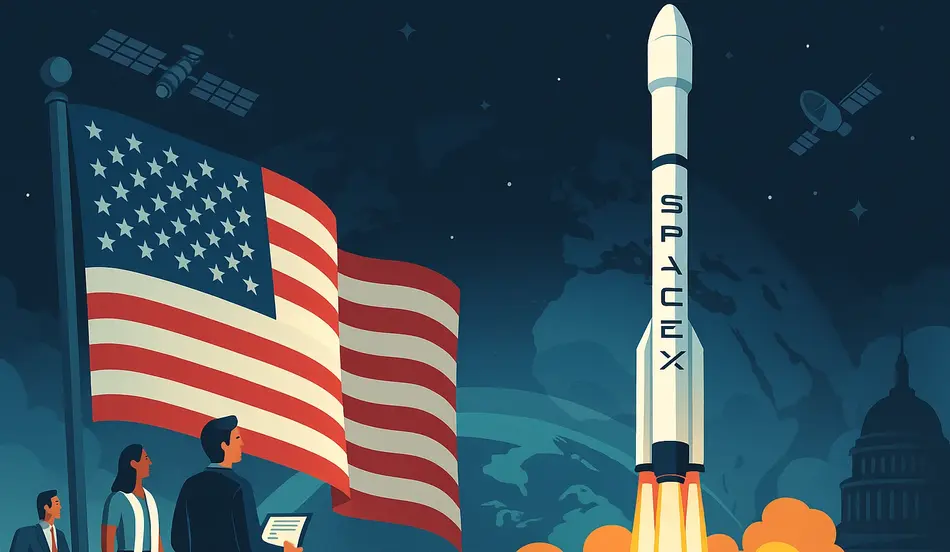In the last two decades, few companies have reshaped an industry as dramatically as SpaceX has done with aerospace. From humble beginnings in 2002, Elon Musk’s private rocket company has grown into a $150 billion powerhouse that not only dominates the commercial launch market but has also become the single most indispensable partner for U.S. space ambitions.
Today, the U.S. government leans on SpaceX for nearly every critical space capability—launching satellites, ferrying astronauts, connecting allies through Starlink, and even supporting defense operations. But this dependency comes with risks. A recent public spat between Musk and President Donald Trump over subsidies and contracts briefly raised the specter of a rupture in the partnership. Although both men quickly walked back their threats, the incident highlighted a pressing question: has the U.S. become too reliant on one man and one company for its space supremacy?
The Rise of SpaceX
When Musk founded SpaceX in 2002 with proceeds from PayPal, the U.S. launch market was dominated by United Launch Alliance (ULA), a joint venture of Boeing and Lockheed Martin. ULA had a de facto monopoly and charged the government hundreds of millions for each launch.
Musk’s pitch was radical: build rockets that could lower launch costs by a factor of ten. Early years were rocky. SpaceX’s first rocket, Falcon 1, failed three times before achieving orbit in 2008. The company was on the brink of bankruptcy. Salvation came through NASA’s new Commercial Resupply Services program, which awarded SpaceX $1.6 billion for 12 cargo missions to the ISS. That deal gave SpaceX the credibility—and the cash flow—to survive.
In 2014, NASA doubled down, awarding SpaceX $2.6 billion to develop the Crew Dragon capsule to transport astronauts. Boeing received even more—$4.2 billion—but struggled with delays and technical failures. By contrast, in 2020, SpaceX made history: launching astronauts from U.S. soil for the first time since the Space Shuttle was retired in 2011.
Today, Crew Dragon is the backbone of NASA’s human spaceflight program, while Boeing’s Starliner has yet to prove reliable.
Market Domination
SpaceX’s dominance isn’t limited to crewed missions. In 2024 alone, the company completed 134 orbital launches, accounting for 83% of all spacecraft placed in orbit globally. Its Falcon 9 rocket has become the workhorse of the industry, used not only by NASA and the Pentagon but even by competitors such as Amazon’s Project Kuiper.
The company’s Starlink satellite constellation, meanwhile, has revolutionized global internet access. By the end of 2024, Starlink represented 65% of all operational satellites in orbit. Its role has gone beyond commercial broadband: in Ukraine, Starlink became a lifeline for military communications.
The success stems from three strategic choices:
- Vertical integration – SpaceX builds nearly everything in-house, from engines to satellites.
- Reusability – Falcon 9’s first stage can be flown multiple times, cutting launch costs dramatically.
- Scale – Musk bet big on mass production. Starlink terminals, for example, are built by the millions, dwarfing global production norms.
This combination has made SpaceX the Ford Motor Company of aerospace—churning out reliable vehicles at industrial scale while competitors still handcraft prototypes.
Hire Talent for the Next Frontier
Post your job on WhatJobs and connect with aerospace engineers, satellite specialists, and innovators ready to scale your business like SpaceX.
Post a Job Now →The U.S. Government’s Dilemma
For NASA and the Department of Defense, SpaceX has become both a blessing and a risk. On one hand, it provides unmatched capability at bargain prices. On the other, reliance on a single company—particularly one led by the unpredictable Musk—creates strategic vulnerabilities.
The Trump administration’s 2025 “One Big Beautiful Bill” heightened tensions by threatening to cut subsidies and contracts for Musk’s ventures. Musk retaliated by hinting he might decommission Dragon spacecraft, a move that could cripple NASA’s astronaut program. Although neither side followed through, the clash revealed the fragility of the relationship.
As one former NASA official put it:
“If we are held over a barrel by not just a company, but an individual who we have no control over—that’s concerning.”
The Defense Dimension
SpaceX’s entanglement with U.S. defense has grown rapidly. In 2022, defense contracts contributed less than $200 million to SpaceX’s revenue. By 2025, projections put that figure at nearly $3 billion, thanks to major contracts with the National Reconnaissance Office (NRO) and Pentagon.
The $1.8 billion Starshield program, a secure satellite network, was awarded to SpaceX to provide encrypted military communications. Unlike Starlink, which is privately controlled, Starshield satellites are owned by the U.S. government, reducing the risk of Musk’s personal veto over military operations.
This arrangement was prompted by Musk’s controversial decision in 2022 to deny Ukraine Starlink access for a military operation, citing fears of triggering World War III. That episode underscored the uncomfortable reality: U.S. military operations were reliant on a private company subject to the whims of its CEO.
SpaceX vs. the Competition
Can competitors catch up?
- Boeing: Despite billions in funding, its Starliner capsule remains unreliable.
- Blue Origin: Jeff Bezos’s space company has ambitions but is years behind in launch cadence and capability.
- Rocket Lab: Innovative but limited to small payloads.
- ULA: Once dominant, it has fallen behind technologically and in cost competitiveness.
NASA and the Space Force are attempting to diversify, awarding contracts to multiple providers for the Artemis lunar missions and national security launches. But experts caution that it takes 15–20 years for a new space company to reach maturity. In the meantime, SpaceX remains irreplaceable.
The Ford Analogy
Some analysts liken today’s space industry to the auto industry of 1913, when Ford’s assembly line made its Model T unbeatable. Governments could buy cars from Ford and enjoy immediate benefits, but doing so risked killing off competitors. Similarly, funneling too many contracts to SpaceX risks cementing a monopoly that could stifle innovation in the long run.
Yet others argue that this is simply how capitalism works: reward the most efficient player. “SpaceX is delivering better than anyone else,” says Lori Garver, former NASA deputy administrator. “The solution isn’t to punish them—it’s to level the playing field through incentives and support for competitors.”
Looking Ahead
SpaceX shows no signs of slowing down. Its Starship rocket, still in testing, promises to be the most powerful launch vehicle ever built and fully reusable. If successful, Starship could slash launch costs further and enable Mars missions, deep-space exploration, and massive commercial projects.
In June 2025, Musk said SpaceX expects to generate $15.5 billion in revenue this year, potentially surpassing NASA’s entire annual budget. With Starlink subscriptions surging, defense contracts climbing, and Starship on the horizon, SpaceX is positioned to remain the dominant force in space for at least the next two decades.
But dominance comes with scrutiny. As the U.S. government, allies, and even competitors increasingly rely on SpaceX, the central question lingers: is it wise for one man’s private company to hold so much sway over national security, global communications, and humanity’s future in space?
FAQs About SpaceX and U.S. Dependence
1. Why is the U.S. so dependent on SpaceX?
Because SpaceX delivers capabilities no other company currently matches: frequent launches, low costs, reliable vehicles, and massive satellite infrastructure. NASA and the Pentagon turned to SpaceX after retiring the Shuttle and as other providers struggled.
2. Could the U.S. replace SpaceX if needed?
Not quickly. It typically takes 15–20 years for a new launch company to become competitive. While NASA and the Space Force are fostering competitors like Blue Origin and Rocket Lab, none can yet match SpaceX’s scale or reliability.
3. What are the biggest risks of this dependence?
The primary risks are geopolitical (if Musk’s decisions clash with U.S. national interests), technical (if Starship or Falcon 9 suffer setbacks), and economic (if competitors fail to survive, leaving a monopoly).
4. How does SpaceX’s Starlink fit into U.S. defense and global strategy?
Starlink has become vital for communications, especially in conflict zones like Ukraine. However, Musk’s unilateral decisions on its use raised alarms. Starshield—a military version controlled by the government—was created to reduce that dependency risk.
Conclusion
SpaceX’s partnership with the U.S. government is one of the most consequential alliances in modern aerospace. Musk’s company has restored American space supremacy, cut costs, and enabled new frontiers. But the U.S. is now navigating a paradox: its greatest strength in space is also a profound vulnerability. Balancing SpaceX’s dominance with the need for competition and oversight will be one of the most important policy challenges of the next two decades.




